Mr. Record at THE Show Newport Beach
This is my second time attending THE Show in Newport Beach. We Southern California audiophiles need an annual show. The painful years we spent deprived of a show of our own are hopefully a thing of the past. Hobbyists of all kinds deserve a chance to gather at least once and year, and independent ultra-high-quality record labels also need a place to remind people that they're still here and making the best-sounding records in the world. Even though many of the brand names and the prices in high-end audio have changed since my first show experience in the late '70s, I crave the adrenaline rush I get from a hi-fi show. It's a unique thrill among thrills. It's a wonderful feeling to gather together and shut out the the general public, which has no interest in our hobby and our passion for music. I've had far too many disappointments trying to explain to coworkers and the occasional stranger that LPs sound better than anything on their iPod. It bores them and I'm sick of their indifference. I think that most audiophiles harbor the same feeling of isolation among their peers, so an annual audio show is a much-needed fix for all of us. I felt a more positive vibe this year than at last year's show. I'm not sure if the change is more in me or if the show really was better. It was certainly bigger, and in this business bigger is definitely better. I was an employee of Cisco Music from 1998 to 2008, and during that time high-end shows meant being trapped in a booth. That's not a complaint, but since Cisco's closing my show experiences are now rather different. Although I'm never more than a phone call away from my boss, Abey Fonn, I have more freedom with my time and with that freedom I'm looking for the fun I missed while booth-bound. Selling records is a blast and I miss it, but cruising around the show with an old friend is something I haven't done since the '80s. Being in an environment where speakers stand on the floor, where tubes glow in abundance, and where some people might actually play some of the same LPs that I own is a much-needed mini vacation. Although I've been attending high-end shows for 35 years, the ten years I spent being tied to a sales booth did not prepare me to write about a show. Next year I plan on taking notes. Because I work in this business, my tendency at shows is to listen to how familiar recordings sound on the various systems. If familiar music sounds correct I will pay closer attention to the components in a system, but if a familiar cut sounds weird -- as is often the case -- I quickly forget about the system I heard. Unfortunately that's easier said than done. Hardware-centric audiophiles are much easier to please than I am. Heavy racks packed with matching faceplates mean little to me if I don't like the music or the sound, but when something grabs my attention, like the Sound Lab A-1PX, I listen with my full attention. I came to the show with my audio/record-collector friend of 26 years, Frank Pernice. Although we both carried our own bags with show directories, Frank earmarked the rooms he wanted to visit, while I rarely looked at mine. Just so long as I avoided the onslaught of reverb-soaked female vocals, any room we drifted into was fine by me. This year I let my ears do the walking. Ironically, I heard a few systems that some of my friends who diligently tried to hear everything missed. I missed good rooms too, but no more than they did. In fact, I haven't talked to anybody who heard the Sound Lab speakers. Much to my amazement, during two days of walking around two separate hotels, I never encountered the sound of a singer shivering in digital reverb or any pseudo-Latin or pseudo-Indian music. Never once did I encounter Patricia Barber, Diana Krall, or Dead Can Dance. Did I just get lucky? Perhaps Patty and Diana are finally buried where they belong, in the graveyard of forgotten schlock next to Amanda McBroom and Enya. Speaking of music, I toted two great recordings with me. A couple of weeks prior to the show I stumbled onto a mono pressing of Ravel's Piano Trio in A minor with Yehudi Menuhin [Angel 35630]. Despite the lean and compressed sound, I fell in love with the performance. On the way down to the show, Frank and I were enjoying some incredibly fun jazz in his car. One of the CDs, A Jazz Band Ball [VSOP 828], caught my attention, especially the second cut, on which the three vibes players, Terry Gibbs, Victor Feldman, and Larry Bunker, played together magically. I quickly realized that this 1957 stereo recording would make a great demo disc. Little did I know the kind of challenge it would present to the yet-unknown audio systems. I've decided to talk about just three rooms and systems, all of which impressed me very much. But I had one important stop to make before doing any listening. I wanted to check in with Abey and see how the Impex records were selling. Impex and Abey mean more to me than any pair of rhodium speaker connectors or anti-resonance device. This year Impex shared space with Elusive Disc. Across from Elusive was another old friend and good customer, Chad Kassem of Acoustic Sounds. He and his new pressing plant have seen a lot of press, but I consider Chad's reissue of Tony Joe White's Home Made Ice Cream just as noteworthy. Knock yourself out trying to decipher Leonard Cohen's vague lyrics. I'd rather trim my toenails. The Swamp Fox, the Whomper Stomper (White's guitar), and his insanely good harmonica playing deserve your attention.
As soon as we walked into the High Water Sound room, Frank said, "Hey, this guy's playing music." Indeed he was -- on LPs too! This was my first encounter with Jeff Catalano, and Frank's few words said a lot. Jeff wasn't just playing audiophile records. He was playing real records, as in the kind that record collectors like to play. It's also nice to play impressive-sounding recordings. It's good for you, as a personal pat on the back for having a great-sounding system. We all do it, but the real value for audio-loving record collectors is to hear how well a system can play our old favorites. Many systems can do justice to Rickie Lee Jones but sound like hell with the Beatles. Jeff's room had a quality that was absent from every other room we entered. I felt as if I had entered his personal listening space. Not only was the sound inviting, but so was the general vibe. I felt as if I could have taken my shoes off and spent an entire day there. The sound was unique and very easy to enjoy. My first thought was that I could hear those horns, but the thought faded quickly as I listened to the ease with which the musical information flowed. Thinking about this now, all audio systems exhibit a certain personality when first encountered. I know that mine does. The difference is that I know my audio system, so I take its colorations for granted and listen past them, or at least most of the time. The fact that the Cessaro Chopins ($40,000/pair) driven by a Tron Discovery GT SE 300B amp ($60,000) were so easy to get used to was a sure sign of this system's transparency, more so than its colorations. Very impressive! There was a time when I would have looked at a $60,000 9Wpc power amp and requested to hear something like the Sheffield Drum Record just to prove to the rep that his equipment was a joke, and there were those times when I'm glad I did just that. Frankly speaking, I'm sure the old Sheffield would have been a disappointment with only 9 watts a side, but in my vast LP collection I don't even own a copy of that silly record. Sure, for the price of the amp alone I'd like a system that plays my recordings that sound best at dangerous levels along with every other record and CD I own, but that was an afterthought. The sound I was hearing was too intoxicating. This was a system that I'd love to return to again, only next time I'm bringing a stack of mono records. I was impressed with how well the Miyajima Zero mono cartridge ($2000) rendered a no-cleaner-than-my-own-mono-copy of Brubeck's Time Out beautifully. Of course, the fabulous TW-Acustic GTS turntable ($12,500) deserves some credit too. This isn't my first encounter with a mono moving coil, but it's the first time that I felt as if there were something to this mono-cartridge trend. Since I own of a large number of mono LPs dating back to the birth of the LP, I would love to get my hands on the Miyajima Zero just to hear what lies within those grooves. It's products like this that feed the old hi-fi bug in me.
Due to Frank's bad ankle we had to take the show at a slower pace than I would have done on my own. But at my own pace, I surely would have missed some demos like the amazing Sound Lab A1PXes ($28,270/pair with optional Consummate back plates). We were taking on the Atrium part of the show on Sunday, and due to Frank's pain we were also using the elevator. As we walked off the elevator I peered into the room with the Sound Labs. I apologize for not being able to describe the all-digital system in a way that a user of this kind of gear would appreciate. I know that a laptop was involved and so was an MSB DAC. The MSB M203 solid-state power amps ($27,500/pair) were unusual looking in that they sat upright, and from a our listening seats they looked more like subwoofers than power amps, but then do power amplifiers always have to look the same? Cables were from Silver Audio. Normally I shy away from large panels of anything, electrostatic or otherwise. I almost passed on this room, and Frank would have followed me, but since the door was cracked open I thought it would be nice to take Frank in. Frank has had a soft spot for large electrostatic speakers ever since he owned a pair of enormous Acoutstat Fours back in the '80s. I have fond memories of listening to Frank's old system. Since I was entering this room for his sake, I figured I'd just bite my tongue and endure some bad sound. The person in the sweet spot (there certainly was a sweet spot) when we entered was a classical-label owner, and the work he was playing was a spirited performance of Mahler's First Symphony. I love Mahler's First, so with only a little trouble I looked past the hard and transistory sound and concentrated on fine music-making. I would buy this recording despite the sound. However, this was a very rare moment in that Frank was ready to leave before I was, and that meant the sound was really bad. In fact, it was so bad that I was absolutely sure the man in the sweet spot must have been hating it as well and was wondering when to make his polite exit. Much to my surprise, he said he liked what he heard and that he also owns the same speakers. The sound reminded me of listening to the Infinity IRSes, a speaker I could never warm up to. Eventually the Mahler stopped and Frank and I made our way to the front row of now-vacated chairs. Of course, I really don't know how the Mahler recording would have sounded on another system. The cause of the hard midrange could have been anything in the system, and even the room itself. Now it was time for us to see what the big 'stats could really do. I asked our host, George Henschke of Blue Skies Audio, if he had anything with tape hiss on his computer. He laughed and asked us to pick something. I responded by asking, "Do you have any stereo jazz from the '50s, with or without vocals?" He asked us if we liked Dave Brubeck -- he had Time Out in high-rez digital. This was my first encounter with music from HDTracks, and I must admit that for the first time I became intrigued with the idea of downloading music. Gone was the hardness we heard with the Mahler. For the first time in my long history with this title, I felt I was hearing the genuine sound of the master tape instead of the mastering systems that have been hiding the sound of the tape. I can't honestly say that I've ever heard the first two cuts of Time Out sound better, and I've heard many LP copies, including the 33 and 45 versions from Classic Records. The Miyajima Zero mono cartridge certainly sounded like it reproduced everything that's on the mono LP, but there was a lot more Brubeck and Desmond here than I've ever heard before. I am a Paul Desmond freak, and I've thought many times that the best reason to play a Brubeck LP is to hear him, but this time I was better able to appreciate the other musicians. Also, for once, I could hear a sound that made sense with minimal miking of the day. The drums were one sound source, and considering that they were recorded with a single mic, they sounded that way. Columbia jazz records from this era image more like classical records than a Blue Note or Contemporary record, due to the large room they were recorded in. The famous 30th Street studio was reproduced better than ever before. The sound seemed so correct that I wonder how it must have sounded on Columbia's JBL monitors at the recording session. Being so impressed with the high-rez Brubeck I had to hear the A Jazz Band Ball CD to see what these speakers could do with the vibes. Often disappointed with recorded vibes, I couldn't wait to see how this system would play them. Damn, these were amazing speakers! Not only did they capture the rarely heard metallic weight, they also again captured the space of the studio better any other system. Also, the tape hiss was correct, and this is not such as easy thing to achieve.
Some would say that I'm saving the best for last. I know Frank would think so, because he's been loyal to Audio Research since the late '80s. Like last year, Optimal Enchantment owner Randall Cooley made a grand showing at the end of a hall. I'm not sure if he planned on using some sort of psychology, but if he was implying "You've heard the rest, now hear the best," he hit the mark. Was it the best system at the show? That's hard to say, but this system sure did things amazingly well. In addition to having the Audio Research Reference 10 line stage ($29,995), also in use was the new Reference 10 phono stage (also $29,995). There were so many top-of-the line components -- including the racks -- that it was hard to keep track of everything. In fact, I didn't even know that a Mac and a DAC were in the system until I read about it on The Audio Beat. It would have been difficult to miss the Vandersteen Model 7 speakers ($50,000/pair with upgraded crossovers), however.
I never saw Randy play anything but LPs, but with an analog front-end like the on he had, who could have possibly missed or wanted to hear any digits? LPs played on the Basis Work of Art turntable sounded amazing. To say that I was extremely impressed with this enormous turntable was an understatement. In the past I had only seen it on static display. Now I've heard it. No doubt the Lyra Atlas cartridge ($9800) is due some credit for the sound as well. While I was in the room a fairly steady flow of audio-fool LPs was beginning to wear on me, and I was curious about just how well this 'table could play the Yehudi Menhuin LP. I was reluctant to ask Randy to play my not exactly mint record (a domestic Angel no less) on a turntable that sells for $179,000. I had already heard this LP in other rooms, and while the music was magical the sound was not impressive. I'm not exactly the big fan of vintage EMI classics that some collectors are, and I've never understood why Decca, Mercury, and Capitol seemed so much better at capturing the wide dynamic range that seemed to elude all but a few EMI LPs, imported or domestically pressed. After hearing just about what I knew was on this LP in other rooms, I was very surprised when this old LP was transformed into a new recording. It was not a silent record by any standard, but it was just about silent when it was played back on the Basis/Lyra combo. In the other rooms the wooden sound of the cello was completely missing, and I figured that it was just an old Angel and many of them sound mediocre. It was no longer mediocre. The cello may have not been as opulent-sounding as on a vintage Fournier or Starker LP, but now it was made of wood and strings. As with the Sound Lab/Brubeck experience, I felt I was hearing the sound that the mics had captured. It was exactly like a piano trio recorded in a slightly larger room than would be appropriate, but incredibly right at the same time. I'd love to spend more time with this system. Does anybody want to buy it for me? There you have it. This two-day show experience was one of the very best I've had. Maybe next year I can get more people to play Impex records in their demos. Speaking of records, I have some oldies to share with you. I've been going back through my collection of 10" monos. I love these records. Clean ones are even harder to find than clean 12" LPs. Also, you can't get a good one pressed anymore. My friends at RTI won't have anything to do with 10" pressings, and I really can't blame them. The market is small. Chris Connor: Sings Lullabys of Birdland [Bethlehem BCP 1001]
I don't believe there is a better-sounding recording of a female jazz singer than this one. She is right there at the front of the speakers and the program is quintessential jazz singing. This ten-incher is always a big hit with my jazz-loving friends. Prior to owning this LP, I never thought I'd hear "Try A Little Tenderness" performed better than Frank Sinatra's or Otis Redding's versions. With this LP there is a third person who makes this song glow with energy, and this time it's a woman. Beethoven: Violin Sonata in F Major, "The Spring" Nathan Milstein (violin) with Arthur Balsam (piano) [RCA LM134] I've become fascinated with the Beethoven Violin Sonatas. Back in the '80s I had two friends who tried to turn me on to the Kreutzer, but I wasn't ready to absorb the music. All I could hear was a violin and a piano, but not the music. In fact, I really wasn't ready until 2007 when I was in New York working on Cisco's 180-gram release of the Kreutzer with Heifetz and Brooks Smith [RCA LSC 2577]. Somehow having to endure the entire master of Heifetz and Smith over an incredible audio system with B&W 802s made me open my mind up to this part of Beethoven's creativity. Since then I've been collecting the Violin Sonatas whenever I bump into them. This 10" LP is one of the best things I've found in recent months. As far as I'm concerned there are only three violinists of the LP era who made the sonatas come to life: Heifetz, Milstein, and Szeryng. Perhaps a bit showy for some? That's your call. I like my music performed, not pondered over. I have yet to hear the Heifetz LP of "The Spring." I have the jacket for the incredibly rare RCA record, but not the disc that goes inside. I checked out MIlstein's late '50s recording made for Capitol on Youtube and it's very nice, but it doesn't do what this 1950 recording does. It's almost hard to explain what makes this performance "rock." "The Spring" does not require the dexterity of the Kreutzer, which, of course, Nathan Milstein had in spades, but the insight of a great artist like Milstein makes it come alive. More so than the excellent recording that Szeryng made with Rubinstein, the team of Milstein and Balsam just seem to make the music sound right. By the way, I do not know what curve this early LP was mastered with. If you have a phono stage with adjustable curves, have at it. I preferred playing this through my Yamaha preamp more than with my purist EAR, because I could boost the top end. Many early LPs sound just right played through an RIAA preamp and this LP sounds perfectly fine played back through either of my preamps, but I wanted a little more treble energy. Perhaps it has more to do with the way the warmish conical Denon DL-103SL cartridge plays it than what playback curve my preamps utilize. The Sandals: The Endless Summer [World Pacific ST-1832]
Many surf LPs were made by amateurs with limited musical skills, but most of the low-brow and lo-fi surf music is found on the Delfi label. The first thing you should notice is that this LP is on World Pacific, and most World Pacific LPs have demo-quality sound. This LP is no exception. Richard Bock was one of the great recording engineers of his time, and since World Pacific was the same company as Pacific Jazz, Bock's excellent work should be familiar to most jazz collectors too. As the original owner of the label, he was behind many great LPs by Chet Baker, Bud Shank, and Chico Hamilton. This LP has a lot to offer. The Sandals were the creation of the Belgian-born Georis brothers, Walter and Gaston. Walter plays the now-familiar Clavichord, but I've never heard it sound like this. Here, it is a cross between a harmonica and an accordion, and it works wonders, giving the music an appropriate lonesome feel and evoking beautiful sunsets on the beach. The other star on this LP is John Blakeley, who plays one hell of a great lead guitar. His searing licks on the magnificent cover of the Shadows' "Jet Black" is worth whatever it takes to acquire this LP, and his poetic playing on the famous title cut will leave you wanting to hear the LP all over again. The sound is also worthy of celebration. The same full-bodied, tubey richness heard on Chet Baker's early recordings is on this LP. World Pacific also released -- of all things -- a jazz record by Ravi Shankar and Bud Shank, and the Pacific Jazz studio was the home of many great folk and bluegrass recordings -- by the Dillards, Hoyt Axton, Glen Campbell, and Jim McGuinn. Apparently the vibe of the place was inspiring, considering the creativity of the famous people who made their first recordings there. One more item of interest: my better-sounding copy of
this LP was mastered by the late Jack Hunt, who also mastered some of Mobile Fidelity's
best-sounding reissues. |


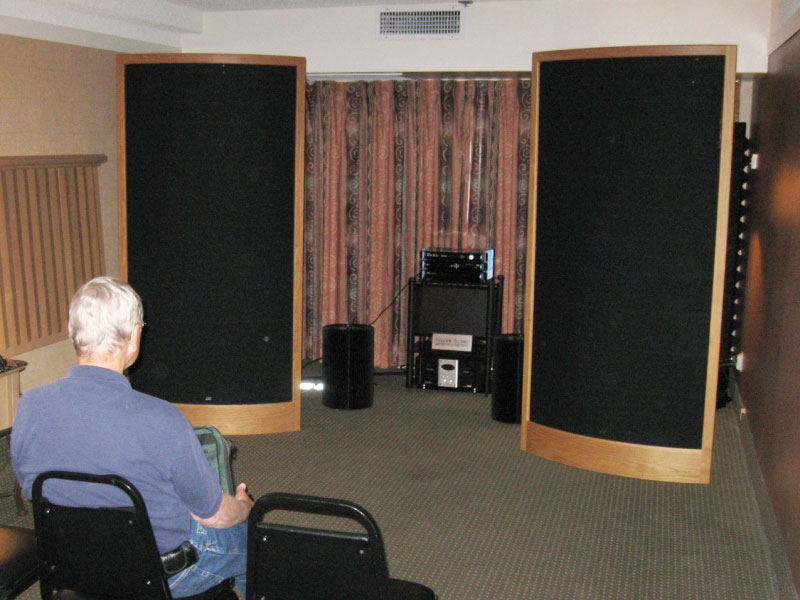
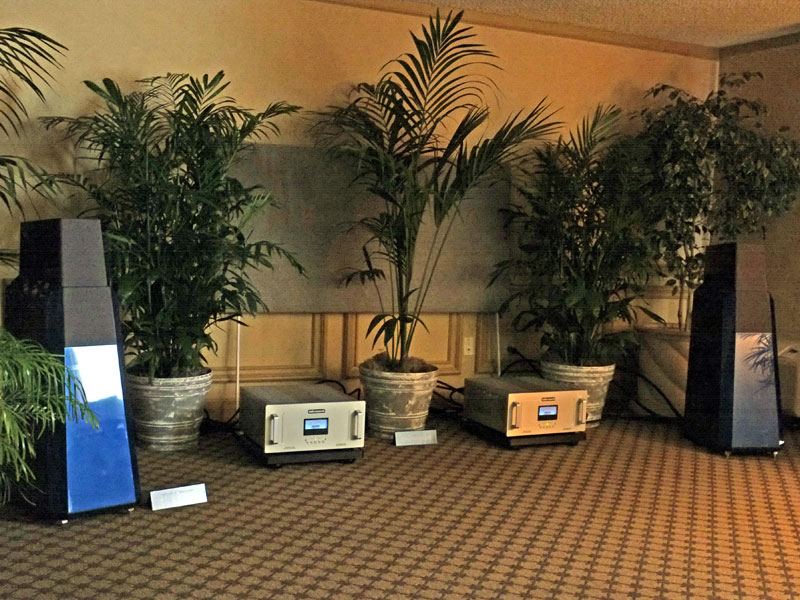
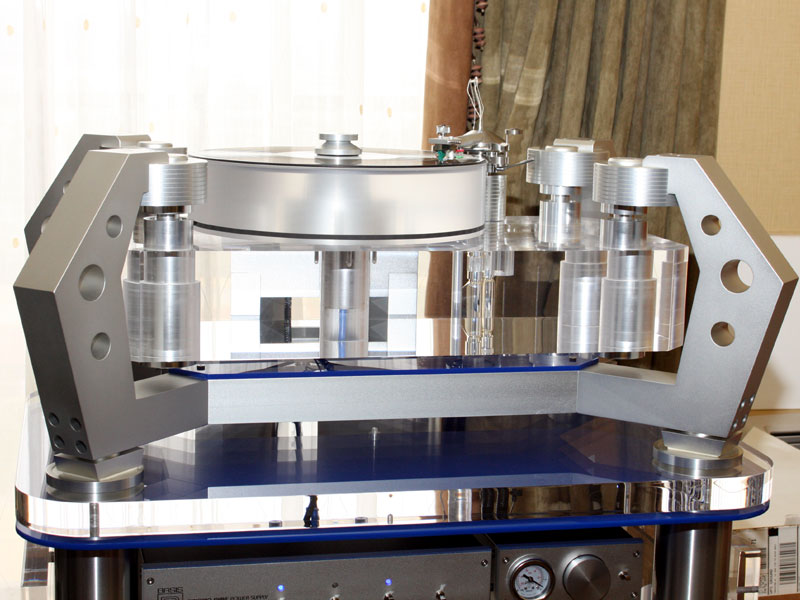
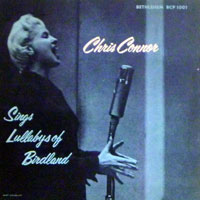 What's cooler than a mid
'50s 10" LP? Not much, but when it's by one of the greatest female jazz vocalists of
the LP era, then it's even cooler. If you know June Christy, you need to know the late
Chris Connor. The discussion of one often leads to the other. At the same time they sound
similar and different. Who's better? Give me a friggin' break. Connor was June's
hand-picked replacement for Stan Kenton's orchestra when she left Kenton to pursue a solo
career. Connor's solo career was just around the corner, and it started with this record.
Recorded on a budget in 1956, this 10" gem beautifully captures the richness of
Connor's voice and the wonderfully mellow sound of the piano-led trio behind her. Just as
Julie London's debut did not utilize a drummer, neither does this session. Minimalism
seemed to work better in the '50s than it does today. Back then you got to hear it without
a wash of digital reverb.
What's cooler than a mid
'50s 10" LP? Not much, but when it's by one of the greatest female jazz vocalists of
the LP era, then it's even cooler. If you know June Christy, you need to know the late
Chris Connor. The discussion of one often leads to the other. At the same time they sound
similar and different. Who's better? Give me a friggin' break. Connor was June's
hand-picked replacement for Stan Kenton's orchestra when she left Kenton to pursue a solo
career. Connor's solo career was just around the corner, and it started with this record.
Recorded on a budget in 1956, this 10" gem beautifully captures the richness of
Connor's voice and the wonderfully mellow sound of the piano-led trio behind her. Just as
Julie London's debut did not utilize a drummer, neither does this session. Minimalism
seemed to work better in the '50s than it does today. Back then you got to hear it without
a wash of digital reverb.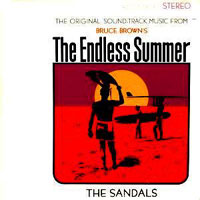 LPs of surf instrumentals
never get much respect among audiophiles, who seem to view music like this as
unsophisticated and beneath them. Perhaps they are waiting to for the Ventures to do an
album of Leonard Cohen songs -- maybe that would legitimize surf music. As this is
unlikely to happen, I invite you to open wide your musical heart and get lost in this
album of mostly original material, the soundtrack to Bruce Brown's famous surfing film.
LPs of surf instrumentals
never get much respect among audiophiles, who seem to view music like this as
unsophisticated and beneath them. Perhaps they are waiting to for the Ventures to do an
album of Leonard Cohen songs -- maybe that would legitimize surf music. As this is
unlikely to happen, I invite you to open wide your musical heart and get lost in this
album of mostly original material, the soundtrack to Bruce Brown's famous surfing film.